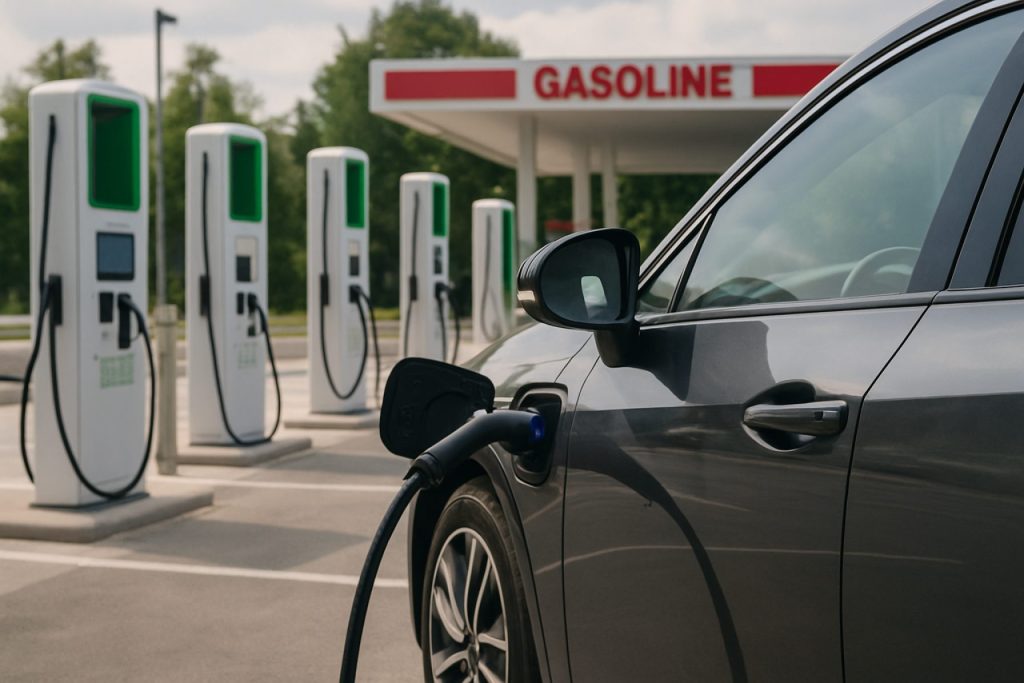
- EV sales are soaring in the U.S., but the public charging network is failing to keep pace, causing widespread anxiety among drivers.
- Major highways and rural areas often lack reliable fast-charging stations, leading to long waits and limited travel options for electric vehicle owners.
- Federal initiatives to expand charging infrastructure have faced obstacles such as funding issues, supply chain delays, and regulatory red tape.
- Reliable, accessible EV chargers are essential for broad adoption, cleaner air, and national climate goals.
- Progress includes unified technical standards and investment incentives, but regional disparities and operational challenges persist.
- The next few years are crucial: charging infrastructure must rapidly expand to match growing EV demand, ensuring electric mobility is accessible and convenient nationwide.
Night settles over a highway rest stop. Beneath the halogen glare, drivers cluster around a handful of working EV chargers, silent anxiety written on their faces as digital dashboards tick down the remaining miles. This uneasy ritual is now familiar across much of the United States—a symptom of an electric vehicle revolution promising freedom, but hemmed in by infrastructure faltering at the seams.
America’s charging network is not keeping pace with the explosion of electric cars. As sales of EVs eclipse records—nearly 1.2 million sold in 2023, according to an industry tracker—the patchwork of fast-charging stations struggles to serve the surge. In cities, drivers jockey for limited plugs at crowded lots. On long trips, rural highways frequently emerge as vast dead zones. Glitches at stations, broken plugs, and long queues can turn a quick boost into an hours-long ordeal. For many would-be converts, these stories fan a suspicion: the promise of convenient recharging, anytime, anywhere, is still distant.
Federal ambitions have lately dimmed. Major national programs aimed at blanketing interstates with reliable stations have encountered snags—red tape, supply chain delays, disputes over funding. Recent shifts in government priorities and spending cast further doubt. Companies constructing the fast-charging grid, from giants like Tesla and Electrify America to startups, now warn of growing uncertainty.
Why does this matter? Electric vehicles—and the cleaner air and quieter cities they promise—cannot flourish without a web of chargers as ubiquitous and dependable as the gas stations that transformed America in the twentieth century. The White House articulated this vision in 2021, setting a target of 500,000 public charging ports by 2030. Three years later, the country remains thousands of stations short, with some entire states sporting vast gaps.
The path ahead looks tangled. Installing a public charging station is all but plug-and-play. Utilities—often slow to approve new connections—must accommodate heavy power draws. Local regulations, permitting delays, and land use fights snarl progress. Manufacturers wrestle with the cost of upkeep and varying technical standards; non-functioning chargers are a frequent complaint. Wildfire, flood, or vandalism can knock sites offline for weeks.
Yet, some bright spots shimmer. Major carmakers, once intent on building rival charging networks, now collaborate to unify technical standards—heralded by Ford and General Motors adopting Tesla’s charging plug. Federal tax incentives encourage private investment. Forward-thinking states like California and New York continue to lead with aggressive buildouts and innovation, even as large swathes of the Midwest and South lag behind.
The stakes stretch beyond convenience. The promise of electric mobility is entwined with national goals on climate change, domestic energy, and industrial leadership. If charging becomes a bottleneck, the entire project stutters. Consumers, wary of inconvenience or stranded investment, may stick to gasoline. Investment could wither, innovation slow.
The next few years will prove critical. For now, the nation’s growing fleet of electric vehicles quietly outpaces the skeleton grid supporting it. The challenge is shared by policymakers, automakers, utilities, and every driver betting that the open road will remain open—to everyone.
Key takeaway: America’s race to electrify its roads faces a pivotal hurdle. The speed and success of the charging network buildout will determine whether electric vehicles become the norm or a stalled promise parked on the roadside.
The EV Charging Crisis: What Automakers, Consumers, and Policymakers Aren’t Telling You
The Full Story Behind America’s EV Charging Shortage
The electric vehicle (EV) revolution is accelerating across the United States, but the infrastructure meant to support it is stuck in the slow lane. While headlines tout the growing number of EVs on the road—nearly 1.2 million sold in 2023 per Edmunds—drivers frequently face long lines, broken stations, and vast charging deserts, especially outside major cities. Let’s dive deeper into the facts, forecasts, controversies, and crucial advice shaping this pivotal moment for electric mobility.
—
Frequently Overlooked Facts About the EV Charging Network
1. Regional Disparities Run Deep
– As of early 2024, more than a third of all U.S. public fast chargers are concentrated in just two states: California and New York (U.S. Department of Energy).
– Rural states—especially in the Midwest and Deep South—can have charging gaps where a single station is separated by 100+ miles.
– Studies from the National Renewable Energy Laboratory (NREL) confirm “charging deserts” can disproportionately affect lower-income and minority communities.
2. Reliability Is the Achilles’ Heel
– According to a 2023 JD Power survey, over 20% of EV users encounter a non-functioning charger on a typical trip.
– The most common issues: payment failures, software glitches, vandalism, and compatibility problems between car and charger.
3. Charging Is Slower Than You Think—for Many
– Level 2 chargers (the most common outside highways) take 4-10 hours for a full charge.
– Only a small subset of stations offers ultra-fast DC charging (80% in 20-40 minutes)—mostly along interstates or in urban centers.
4. Costs to Install a Fast Charger Are Skyrocketing
– A typical DC fast-charging station (4-6 plugs) can cost $300,000 to $700,000 to build (McKinsey, 2022), due to electrical upgrades, grid access, and permitting.
– Ongoing maintenance and software support add significant annual expenses.
5. Security and Sustainability Concerns Are Growing
– Cybersecurity breaches: As chargers become more connected, they’re increasingly susceptible to hacking, with recent studies (MIT Review, 2023) finding vulnerabilities in charger software.
– Vandalism and copper theft are on the rise, especially in remote locations.
– The sustainability of charger manufacturing is still under scrutiny; e-waste and supply chain emissions have yet to be fully quantified.
—
How-To: Avoid EV Charging Nightmares
1. Plan Routes in Advance: Use multiple apps (like PlugShare, ChargePoint, or Electrify America) to check charger availability and functionality in real time.
2. Always Have a Backup: Identify at least two alternate charging stops before long trips.
3. Charge Off-Peak: Early morning or late night can mean shorter lines and more reliable stations.
4. Carry Adapters: As plug standards evolve, keep adapters for both CCS and NACS (Tesla) plugs.
—
Real-World Use Cases
– Urban Renter: Without home charging, city drivers depend on public chargers—leading to “range anxiety” and fierce competition at public lots.
– Long-Haul Driver: Cross-country travel in an EV may require up to 3x more stops than a gasoline vehicle unless you stick to the Tesla Supercharger network.
—
Market Forecasts & Industry Trends
– The U.S. fast-charging network is expected to triple by 2028, fueled by billions in federal and private investment (BloombergNEF).
– Major automakers are forming alliances, such as the North American Charging Standard (NACS), to create interoperable charging solutions.
—
Reviews & Comparisons
– Tesla Supercharger: Highest reliability and uptime, but transitioning to be available to more brands.
– Electrify America: Broad coverage but often criticized for reliability.
– EVgo & ChargePoint: Strong urban footprint, but gaps along interstate corridors.
—
Controversies & Limitations
– Permitting Gridlock: Local utility “queues” have delayed new stations by as much as 18 months.
– Equity Issues: Concerns about fairness for communities without access to home charging or reliable public infrastructure.
– Charger Access Fees: Some networks now charge session fees or memberships, raising the cost of “fueling” an EV in some areas above that of gasoline (CNBC, 2024).
—
Features, Specs & Pricing
– Level 2 Chargers: 6-20 miles of range per hour of charging; $2–$4K installed at home, $0.10–$0.45 per kWh on public networks.
– DC Fast Chargers: 150-350 kW; up to 200 miles added in 20-45 minutes; $30–$45K per plug for hardware alone.
—
Security & Sustainability
– Cybersecurity hygiene: Frequent software updates are critical. Only use trusted networks.
– Resilience: Look for stations advertised as “weather hardened” or backup generator-supported for emergencies.
—
Pros & Cons Overview
| Pros | Cons |
|——————————-|—————————————-|
| Lower operating cost per mile | Charging network reliability is poor |
| Reduced emissions & noise | Long charging times for some EVs |
| Tax incentives for buyers | Range anxiety remains a barrier |
| Home charging is convenient | Urban/rural disparity in infrastructure|
—
Most Pressing Questions Answered
Q: Is charging an EV really cheaper than gasoline?
A: Yes, for most drivers charging at home or off-peak, but public fast chargers in expensive states can narrow the price gap.
Q: What states are best for EV ownership?
A: California, New York, Colorado, and Oregon lead in charger density per capita and government support.
Q: How long until charging is as easy as gasoline?
A: Experts predict parity could be achieved by 2030—if investment and regulatory delays are resolved (IEA, 2023).
Q: Which vehicles have the best public charging access?
A: Tesla vehicles, due to the extensive Supercharger network, though this is changing as more brands gain access.
—
Insights & Predictions
– Interoperability Will Decide the Winner: As Ford, GM, and other brands embrace Tesla’s NACS, expect fewer compatibility issues ahead.
– Rental and Multi-Family Charging Solutions: New policies and tech are making it easier to install stations in apartment complexes and workplaces.
– Renewable Energy Integration: Solar and battery backups will increasingly support ultra-fast chargers, reducing their grid impact.
—
Actionable Quick Tips for EV Owners and Shoppers
1. Join Multiple Charging Networks: Sign up for apps and accounts with the major providers before your first trip.
2. Monitor Incentives: Federal and state tax credits can lower both the cost of EVs and at-home charging station installation.
3. Push for Local Solutions: If your area lacks public charging, petition local government or utility providers for funding.
4. Check Your Car’s Compatibility: Confirm your EV supports the latest plug standards and fast-charging specs.
—
Conclusion
The electric future is here—but accessing its benefits requires planning, patience, and advocacy. Whether you’re considering an EV or already own one, staying informed about the evolving U.S. charging landscape puts you in the driver’s seat. For news, reviews, and essential EV buying tips, visit Edmunds to keep your journey smooth and stress-free.



